Xiaomi Mi Note 2 vs. Samsung Galaxy S7 edge: Bargain bin
Bargain bin

Retail package
The Mi Note 2 comes in a box just like any other Xiaomi smartphone, budget or flagship, barring the fancy Mi Mix. In the plain white package you'll find the phone, a fast charger and a USB cable. Our review unit came with a clear silicone bumper bundled, but the Xiaomi official website makes no such promises, so it may have been a retailer addition. There's no headset bundled, but a pair of Xiaomi Pistons is less than $10 shipped.


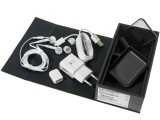
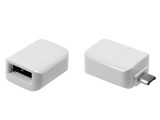
Plain white box • Basics only • Classy all-black packaging • USB OTG adapter
The Galaxy S7 edge is in a different league here. It goes beyond the stealth black box. The S7 edge packs a quick charger and a USB cable, naturally, but adds a USB OTG dongle, and a separately packaged headset.
Cheaper, but just as good: Not really, no. Xiaomi's barebones retail bundle can't compete with the full package Samsung ships to you.
Design
The dual-curved Xiaomi Mi Note 2 is simply begging for comparisons to the Galaxy S7 edge. Okay, maybe to the Galaxy Note7, strictly speaking, but that's not too practical with the Note7 being discontinued and all, is it? We've therefore settled for the next best thing.

Samsung's curves are bolder and more striking, with the minimal side bezels almost making the screen look like it spills to the sides. The Mi Note 2's display is ever so slightly curved, just enough to be called so and has a fair bit of frame on the sides, so not quite as eye-catching.



Xiaomi Mi Note 2 next to the Samsung Galaxy S7 edge
The S7 edge is altogether smoother and more fluid - its corners are more rounded, even the otherwise thin aluminum frame doesn't feel sharp against your fingertips. The Mi Note 2 has a more professional, business-like look.




Xiaomi Mi Note 2 all lit up • Curves up close • S7 edge's 5.5" of AMOLED gold • More curves
Both phones have glass backs. The Galaxy S7 edge's is covered with a Gorilla Glass 4 layer (same as its front), while Xiaomi makes no such claims. The S7 edge is also IP68 certified and that's 68 more than the Mi Note 2, so to speak - the Xiaomi phone is not rated to withstand dust or water encounters.
Samsung made a big deal back when the S7/S7 edge pair was announced how the camera no longer sticks out as much as on the S6. Well, neither does the Mi Note 2's.


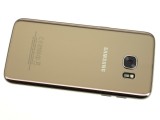
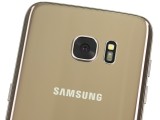
No-nonsense glass back • ...camera and flash • more glass • assorted sensors under the flash
The Mi Note 2 is also the larger phone - after all it does have a little more display to fit. While you're unlikely to care about the 5mm difference in height, the 5mm narrower S7 edge is a lot more easily manageable. The Mi Note 2 is thinner though, and feels more so than the 0.1mm difference would suggest.


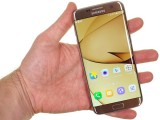

Mi Note 2 in the hand • Galaxy S7 edge in the hand
Both phones have a classic mechanical home button with a fingerprint sensor in it - while that's the way Samsung's been doing it for ages (only adding the fingerprint reader later), Xiaomi's rocking back and forth between this here implementation and back-mounted sensors.
The Mi Note 2 is a dualSIM device and it can take two nanoSIMs, but you'll notice that's no hybrid slot there - storage can't be expanded, it's either 64GB or 128GB, whatever you get from day one. The Galaxy S7 edge, on the other hand, will happily take Samsung's 256GB microSD cards (just as happily as any other microSD card) for a maximum of 320GB if you've opted for the 64GB storage version. There are also dualSIM versions of the Samsung flagship too, with a hybrid slot.




Home, sweet home: Mi Note 2 • Galaxy S7 edge • 2x nanoSIMs on the Mi Note 2 • nanoSIM and microSD
Samsung was being stubborn in refusing to adopt the Type-C port until last minute and the S7 edge comes with a regular microUSB connector. The Mi Note 2 is better futureproofed with its Type-C connectivity. It also scores points for its IR blaster on top - a feature Samsung ditched with the S6 edge+/Note5 to likely never be seen again on its flagships. Both phones have 3.5mm jacks, just saying.




Type-C on the Mi Note 2 • old-school microUSB on the S7 edge • IR blaster - check • nope, none here
Cheaper, but just as good: Aaaalmost. The Mi Note 2 looks and feels as premium as the S7 edge, and we appreciate the serious design. And the IR blaster, and Type-C port. But the lack of storage expansion and waterproofing lets it down.
Screen
It's about the curves here, first and foremost - the displays on both devices have rounded edges on the sides - but make sure you look deeper, because there's a lot setting them apart.
Both phones are using OLED displays, only differently sourced ones. Samsung, being Samsung, has fitted the S7 edge with one of its own cutting-edge Super AMOLED panels, while the Mi Note 2 relies on an LG-made unit.
The Galaxy S7 edge is equipped with a 5.5-inch display with QHD resolution, resulting in a pixel density of 538ppi. The Mi Note 2, on the other hand has a larger 5.7-inch diagonal and fewer pixels - its resolution is FullHD, for a pixel density of 386ppi.


Mi Note 2's 5.7-inch display could have been sharper • The S7 edge sets the standard here
Both panels have a similar subpixel arrangement. Samsung calls it Diamond Pixel and in its case it means twice as many green subpixels as the other two colors, while the Mi Note 2 packs twice as many blue subpixels as red and green ones.
There's an inherent disadvantage to such a subpixel pattern which lies in the fact that three dots of each primary color don't form one pixel and subpixel rendering needs to be employed. That can lead to not ideally sharp straight lines and fuzzy tiny texts. Samsung combats the issue with brute force by using more pixels and it works - the pixels are so tiny you can't see them. Not so on the coarser Mi Note 2 display where you could spot the diagonal patterns.
Now that we've covered the Mi Note 2's major disadvantage in this clash, let's move on to the tests. In terms of maximum brightness, the Mi Note 2 can't even match the S7 edge, when the Samsung flagship is in Manual mode. Flip the Auto toggle and the S7 edge can get a huge boost in bright conditions - 610 is a lot of nits. The Mi Note 2's minimum brightness is not great either - at close to 20nits it may be too bright for night time browsing, whereas the S7 edge can go as low as 1.8nits.
The S7 edge also has truly infinite contrast - when displaying pure black it just keeps the pixels off, like a true AMOLED. On the Mi Note 2, on the other hand, we did measure some illumination when displaying black - it's ever so slight and still results in an exceptionally high contrast, just not on par with the S7 edge.
| Display test | 100% brightness | ||
| Black, cd/m2 | White, cd/m2 | ||
| 0.005 | 341 | 68200 | |
| 0.00 | 392 | ∞ | |
| 0.00 | 610 | ∞ | |
In our sunlight legibility test the S7 edge posts the second best number we've seen, a little bit behind Samsung's own S6 edge+ from last year. Not so for the OLED panel in the Mi Note 2, which is bested not only by AMOLEDs but also by many of the good LCDs.
Sunlight contrast ratio
-
Samsung Galaxy S6 edge+
4.615 -
Samsung Galaxy S7 edge
4.439 -
OnePlus 3
4.424 -
Samsung Galaxy S7
4.376 -
HTC One A9
4.274 -
Samsung Galaxy Note7
4.247 -
Samsung Galaxy A3
4.241 -
OnePlus 3T
4.232 -
Google Pixel XL
4.164 -
ZTE Axon 7
4.154 -
Samsung Galaxy S6 edge
4.124 -
Samsung Galaxy Note5
4.09 -
Huawei Nexus 6P
4.019 -
OnePlus X
3.983 -
Vivo Xplay5 Elite
3.983 -
Apple iPhone 7
3.964 -
Oppo R7s
3.964 -
Huawei P9 Plus
3.956 -
Samsung Galaxy A7 (2016)
3.918 -
Samsung Galaxy C5
3.911 -
Samsung Galaxy C7
3.896 -
Samsung Galaxy A5
3.895 -
Samsung Galaxy J7 outdoor
3.879 -
Samsung Galaxy J2 outdoor
3.873 -
Samsung Galaxy A8
3.859 -
Samsung Galaxy A9 (2016)
3.817 -
Motorola Moto X (2014)
3.816 -
Samsung Galaxy J7 (2016) outdoor mode
3.802 -
Xiaomi Redmi Pro
3.798 -
LG V20 Max auto
3.798 -
Sony Xperia XZ
3.795 -
Samsung Galaxy A5 (2016)
3.789 -
Apple iPhone 6s
3.783 -
Meizu Pro 5
3.781 -
Microsoft Lumia 650
3.772 -
Samsung Galaxy J7 (2016)
3.756 -
Oppo F1 Plus
3.709 -
Vivo X5Pro
3.706 -
Sony Xperia X Compact
3.694 -
Apple iPhone SE
3.681 -
Huawei Mate 9
3.68 -
Samsung Galaxy A7
3.679 -
Meizu PRO 6
3.659 -
BlackBerry Priv
3.645 -
Apple iPhone 7 Plus
3.588 -
Apple iPhone 6s Plus
3.53 -
Motorola Moto Z Play
3.526 -
Samsung Galaxy J3 (2016) outdoor mode
3.523 -
Samsung Galaxy J3 (2016)
3.523 -
Acer Jade Primo
3.521 -
Microsoft Lumia 950
3.512 -
Oppo R7 Plus
3.499 -
nubia Z11
3.466 -
Samsung Galaxy J7
3.422 -
Meizu MX5
3.416 -
LG V20
3.402 -
Oppo R9s
3.352 -
Oppo R7
3.32 -
Xiaomi Mi 5s
3.276 -
Samsung Galaxy J2
3.235 -
Sony Xperia X Performance
3.234 -
Xiaomi Mi Note 2
3.228 -
Motorola Moto X Play
3.222 -
Huawei P9
3.195 -
Lenovo Vibe Shot
3.113 -
Motorola Moto X Force
3.105 -
LG Nexus 5X
3.092 -
Huawei Mate S
3.073 -
Microsoft Lumia 640 XL
3.065 -
Sony Xperia X
2.989 -
Huawei Mate 8
2.949 -
Xiaomi Redmi 3S
2.913 -
Sony Xperia XA Ultra
2.906 -
LG G5
2.905 -
HTC One S
2.901 -
Xiaomi Redmi 3s Prime
2.893 -
Xiaomi Mi 5s Plus
2.884 -
Sony Xperia Z5
2.876 -
Microsoft Lumia 550
2.851 -
Xiaomi Redmi 3 Pro
2.803 -
Sony Xperia Z5 compact
2.784 -
Meizu MX6
2.751 -
LG V10
2.744 -
Xiaomi Redmi 3
2.735 -
Sony Xperia M5
2.69 -
Huawei P9 Lite
2.679 -
Xiaomi Redmi 4 Prime
2.679 -
Vivo V3Max
2.659 -
Xiaomi Mi Mix
2.658 -
Xiaomi Mi 4i
2.641 -
Sony Xperia XA
2.609 -
Motorola Moto G4 Plus (max auto)
2.582 -
Motorola Moto G4 Plus
2.582 -
Xiaomi Mi 4c
2.574 -
LeEco Le Max 2
2.567 -
Asus Zenfone 3 ZE552KL
2.563 -
Microsoft Lumia 640
2.563 -
Lenovo Moto G4
2.544 -
Oppo F1
2.528 -
Sony Xperia Z5 Premium
2.525 -
Huawei Honor 7 Lite / Honor 5c
2.506 -
Sony Xperia M4 Aqua
2.503 -
Oppo F1s
2.481 -
Motorola Moto G
2.477 -
Lenovo Vibe K5 Plus
2.473 -
Huawei G8
2.471 -
Huawei nova
2.467 -
Sony Xperia Z
2.462 -
Lenovo Vibe K5
2.459 -
Meizu m3 max
2.447 -
Huawei Honor 7
2.406 -
Sony Xperia E5
2.386 -
ZUK Z1 by Lenovo
2.382 -
HTC 10
2.378 -
Samsung Galaxy J5 (2016)
2.378 -
Meizu m1 note
2.362 -
Huawei nova plus
2.329 -
HTC One E9+
2.305 -
Alcatel One Touch Hero
2.272 -
Apple iPhone 4S
2.269 -
Lenovo Vibe K4 Note
2.254 -
Sony Xperia C5 Ultra
2.253 -
Xiaomi Redmi Note 3 (MediaTek)
2.249 -
Sony Xperia C4 Dual
2.235 -
Xiaomi Mi Note
2.234 -
Motorola Moto G (2014)
2.233 -
LG Nexus 5
2.228 -
Huawei P8
2.196 -
Huawei Honor 6
2.169 -
Xiaomi Redmi Note 2
2.166 -
OnePlus Two
2.165 -
HTC One X
2.158 -
LG Aka
2.145 -
Xiaomi Redmi Note 4
2.145 -
Archos 50 Diamond
2.134 -
Xiaomi Redmi Note
2.119 -
Acer Liquid X2
2.084 -
Huawei P8lite
2.078 -
Moto G 3rd gen max manual
2.026 -
Xiaomi Mi Max
1.996 -
Sony Xperia E4g
1.972 -
OnePlus One
1.961 -
Meizu m3 note
1.923 -
Meizu m2 note
1.892 -
BlackBerry Leap
1.892 -
ZTE Nubia Z9 mini
1.759 -
Sony Xperia U
1.758 -
Asus Zenfone Selfie
1.68 -
Motorola Moto E (2nd Gen)
1.675 -
ZTE Nubia Z9
1.659 -
Jolla Jolla
1.605 -
Motorola Moto E
1.545 -
Sony Xperia M
1.473 -
HTC Desire C
1.3 -
Sony Xperia C
1.283 -
Meizu MX
1.221 -
Sony Xperia E
1.215
As for color reproduction, the Mi Note 2's default color mode results in an average DeltaE of 5.4 with a maximum of 8.7 - better numbers than the S7 edge's 7.2 and 12.4. Both phones have more color-accurate modes, though, and in the best one the Mi Note 2 manages an average DeltaE of 2.7, compared to the S7 edge's super-precise 0.8. It's worth pointing out though, that the Mi Note 2 is only accurate when viewed head-on - at any other angle it's a marred by a strong bluish tint.
Cheaper, but just as good: Nope, not by a long stretch. The Galaxy S7 edge's display is superior in every respect - resolution, brightness, contrast, color accuracy.
Battery
The Samsung Galaxy S7 edge packs a 3,600mAh battery - quite a lot by Samsung flagship standards. The ill-fated Note7 had a smaller 3,500mAh battery for a larger 5.7-inch diagonal. The 5.7-inch Mi Note 2 holds even more juice - 4,070mAh.
As for battery life, the Mi Note 2 does a respectable job scoring a 92h Endurance rating. It's particularly efficient in video playback where it'll last more than 15 hours before calling it quits. 3G voice call longevity won't be an issue either, with almost 28 hours on the clock before the battery calls it quits. It's not as great on the web though - less than 9 and a half hours.

We've tested both versions of the S7 edge - one with the Exynos 8890 chipset and one with the Snapdragon 820, and they do produce quite different results.
It's the Exynos that is more energy efficient, outlasting the Snapdragon in all tests. While the 'international' version does a few minutes over 20 hours in video playback test, the Snapdragon-powered S7 edge 'only' lasts 17h - still an hour and a half more than the Xiaomi phablet.

In Web browsing the S820 S7 edge is a bit of a letdown with its 10 hours - better than the Mi Note 2, but nowhere near the Exynos' 13:32h. Neither S7 edge can match the Mi Note 2's voice call longevity.

Cheaper, but just as good: Yes, or sort of, depending on which version S7 edge you're comparing to. The Mi Note 2 outlasts both in voice calls, and is close to the S820 S7 edge in the other disciplines, but the Exynos version is hard to beat overall.
Reader comments
- Irtiza A.
- 16 Dec 2021
- bJ9
nope galaxy note edge was the first in 2014
- Anonymous
- 18 Jan 2017
- gNT
Get your facts correctly. Xiaomi was the brand that started the curve display first with its mi note. Mi note 2 is built on that platform.
- AnonD-608498
- 17 Jan 2017
- PxI
True a typo, but as you know I meant the 7 and the point remains the same.